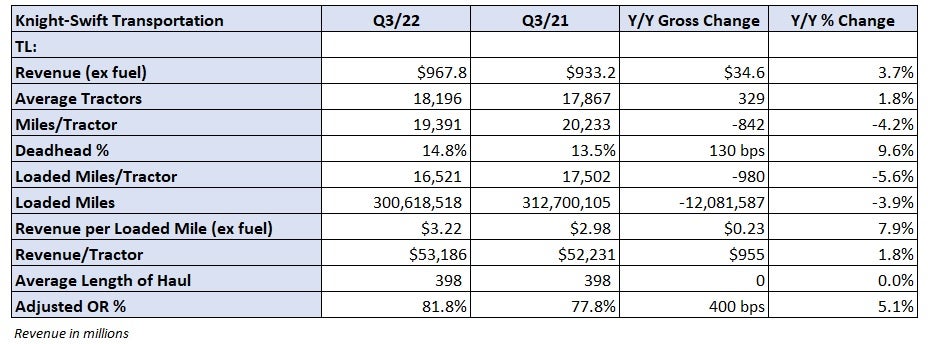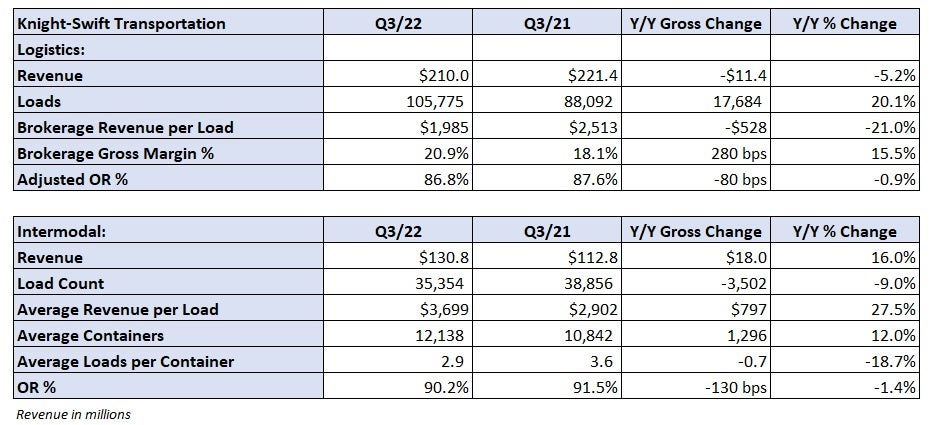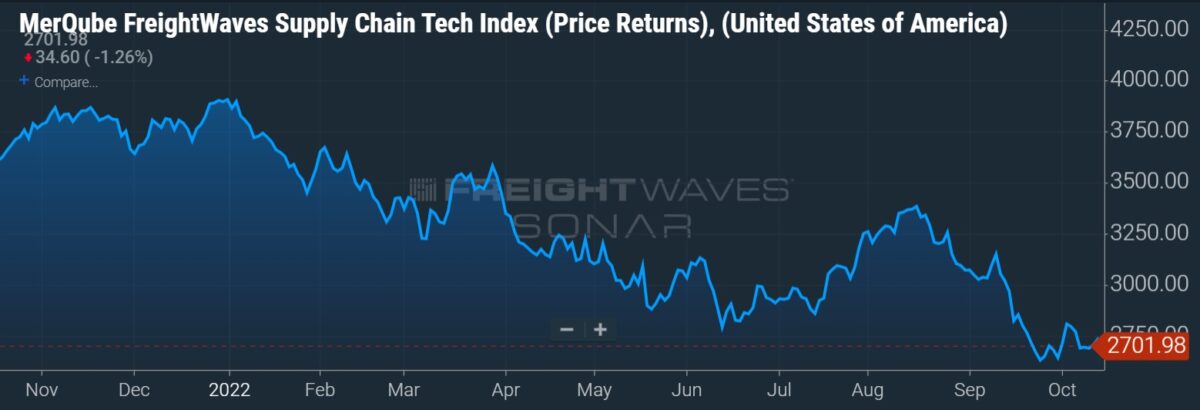Knight-Swift Transportation missed third-quarter earnings expectations Wednesday and lowered its outlook for the rest of the year.
Knight-Swift (NYSE: KNX) posted adjusted earnings per share of $1.27, 5 cents light of consensus and 3 cents lower year over year (y/y). The company now expects full-year adjusted EPS of $5.17 to $5.22 compared to the prior guide of $5.30 to $5.45 and the consensus estimate of $5.39 at the time of the print. Softening freight fundamentals and a “muted peak season” were the reasons cited.
“It’s rare that you go into a fourth quarter and not see some type of seasonal uplift and projects and spot opportunities,” said CFO Adam Miller on a call with analysts. “Especially with companies of our scale, we typically get some of these large, kind of difficult projects to handle and they typically pay a premium; … none of that stuff materialized.”
Management was quick to reiterate a $4 floor for EPS that it first referenced during the height of the freight boom. It also believes a slowing freight environment will turn the M&A market around from sellers being able to command high valuations to one that is more buyer-friendly.
“We expect meaningful, attractive acquisition opportunities over the next few quarters,” said President and CEO Dave Jackson. The company has completed seven acquisitions over the past five years, including the purchase of two less-than-truckload carriers. Knight-Swift has generated more than $1 billion in free cash flow over the recent 12-month period, which it may use to purchase other fleets and “transportation-related” companies. It also plans to organically expand its existing businesses.

Higher costs pushed the adjusted operating ratio in the truckload segment up 400 basis points y/y to 81.8%. Revenue excluding fuel surcharges was 4% higher y/y at $968 million as average tractors in service increased 329 units, revenue per loaded mile (excluding fuel) was up 8% and loaded miles per tractor fell 6%.
“This was the first quarter in quite a while where the rate [per loaded mile] was only up single digits and clearly our costs are up more than single digits on a y/y basis,” Jackson said. “That is the reality that we are facing as truckload carriers going into the bid season.”
The lack of specialty and project freight weighed on the yield metric in the period as cost per loaded mile climbed 13% y/y.
Jackson said the highest-ever cost profile throughout the industry is pushing fleets to either sell or shut down. He said carriers dependent on the spot market, where capacity is abundant and rates have plummeted, are leaving faster than in prior downturns, and even ahead of contractual rate declines. In most cycles, changes in contract rates lag changes in spot rates by roughly six months.
“Anecdotally, we hear from those that have receivables with small carriers, and it has turned ugly very, very quickly for them,” Jackson said. “The pressures just continue to mount. I wouldn’t be surprised if there aren’t many small carriers that were just holding out hope for a strong fourth quarter to bail them out of a tougher summer with no spot [freight].”
This cycle didn’t see the capacity additions like those of past cycles as carriers were unable to find drivers or acquire incremental equipment due to OEM production challenges.
Management’s guidance for the TL segment during the fourth quarter calls for rates to turn negative y/y on weaker spot market yields and fewer opportunities outside of contractual agreements.

The LTL division reported a 15% y/y increase in shipments per day with revenue per shipment climbing 9% y/y (excluding fuel). The division posted an 84.5% adjusted OR, which was 300 bps better y/y. Knight-Swift will add or expand four terminals during the fourth quarter, resulting in the addition of 125 doors in the network.

Logistics revenue fell 5% y/y to $210 million as a 20% increase in loads was offset by a 21% decline in revenue per load (down 12% from the second quarter). The company doesn’t disclose the percentage of its spot brokerage business. Gross margin was up 280 bps y/y to 20.9%. The adjusted OR improved 80 bps y/y to 86.8%.
Guidance calls for loads to remain stable in the fourth quarter alongside lower revenue per load y/y. The OR is expected to remain in the mid- to high-80% range.
Intermodal revenue increased 16% y/y to $131 million. Loads were down 9% y/y (down 3% sequentially) even as the number of containers in service increased 12%. The combination led to a 19% decline in container turns during the quarter. Knight-Swift’s volume results lagged the broader industry as well. Container volumes on the U.S. Class I railroads were down only 1% y/y in the third quarter.
Intermodal revenue per load jumped 28% y/y, driving 130 bps of OR improvement at 90.2%.
Intermodal volumes are expected to improve y/y in the fourth quarter with margins remaining level.

Shares of KNX were off 5.3% in after-hours trading. Prior to the report, the stock was off just 1.6% since the reporting of second-quarter results on July 20. By comparison the MerQube FreightWaves Supply Chain Tech Index (SCTI) is down 12.3% over the same time. The SCTI measures share price performance of tech-enabled supply chain services providers like Knight-Swift.

More FreightWaves articles by Todd Maiden
- Logistics real estate market moderating but rents going higher
- J.B. Hunt looks to balance costs with moderating demand
- XPO, RXO financial targets imply no letup through 2027







